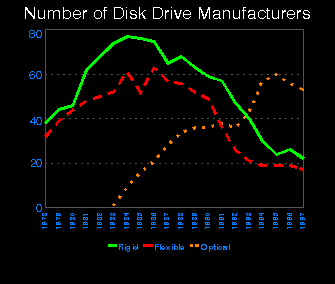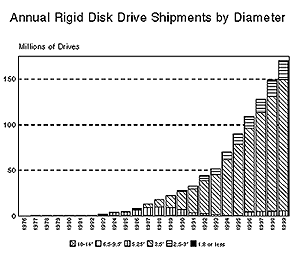
IDEMA Insight
| Volume IX , No.5 |
WHERE DO WE GO FROM HERE?
By James N. Porter, DISK/TREND, Inc.
As human enterprises go, the disk drive industry is rather unusual.
Product life cycles are shorter than for most other technology products. In fact, they're a small fraction of the life cycles for other types of products. An odd combination of professional skills is required to develop and manufacture the disk drive industry's products, including chemists, physicists, a variety of materials scientists, electrical engineers, mechanical engineers and computer scientists Over the years, it has become clear that a rare combination of management skills is necessary to organize such a diverse group of specialists and managers into an efficient enterprise and to provide the leadership to satisfy the market's incessant demand for more storage capacity, faster access, smaller packaging and lower prices.
A majority of the companies which have entered the disk drive industry during its 40 year history have dropped out because they found it too difficult to simultaneously manage the many aspects of the technology, the complex multinational manufacturing programs, the challenging product management requirements, and the fast evolution of the worldwide market. More than 220 disk drive manufacturers have withdrawn from the business, leaving 90 still active in the field, only 26 of which produce rigid disk drives (Figure 1). The surge of additional optical disk drive manufacturers in recent years has been generated by booming sales of CD-ROM drives, but it seems certain that the total count of CD-ROM and DVD drive manufacturers will also start to decline before the end of the decade, leaving only the up-to-date, efficient producers.

Figure 1: Number of disk drive manufacturers.
Two Key Factors Generate the Disk Drive Industry's Growth
The underlying reasons for the industry's sustained growth can be traced to continuous improvements in disk drive technology and the nonstop appetite of numerous markets for more data storage capacity. It is unrealistic to assume that either phenomenon will go on forever, but the industry's confidence in continuing to achieve rapid advancement during the next five years seems justified, short of unprecedented natural disasters or political bungling.
During the 1990s the highest areal density utilized in leading edge rigid disk drives has increased by slightly more than 60% per year, and the current general expectation that a 60% annual rate of increase will be maintained throughout the rest of the decade is reasonable. The anticipated result will be production of the first drives with areal density reaching 10 Gb/in2 by the beginning of the next century.
Areal density is not an isolated technology measurement. It's been the key measurement of the industry's advances for 40 years, because the result of improved areal density is a more cost-effective disk drive -- smaller physical size, higher capacity, combined with the lower parts count which reduces product cost. By the year 2000 (Figure 2), leading edge 3.5 inch drives can be expected to provide almost 13 gigabytes per disk; and 2.5 inch drives, more than 6.5 gigabytes.

Figure 2: Higest density rigid disk drives.
You can draw your own conclusions as to what the leading manufacturers' product lines will look like in 2000. Bear in mind that the industry's high end rigid disk drives for network file servers and mainframes in that year will probably continue to utilize disks recorded at 75% - 100% of the leading edge areal density, as they do today, and that drives produced at high production volume for desktop personal computers will probably still be mostly in the range of 40% - 50% of that year's leading edge areal density. It is reasonable to assume that the average disk count per drive will decline, but the extent of the decline will be controlled by the nature of the demand for data storage in 2000.
It's easy to oversimplify the subject of demand for disk drive storage capacity. In actuality, the market is driven by applications as diverse as analysis of meteorological data, printing payroll checks, writing letters, browsing the Internet, editing television commercials, searching a data warehouse, or playing a computer game -- plus a growing list of other applications, limited only by human imagination. It would be foolish to try to define the limits of the usefulness of the computer or the extent of the data that humans will choose to store.
But the past is frequently a map of the future, and storage is a territory with many signposts. For example, personal computers are still used by only a minority of the population, even in the most industrialized countries. History teaches us that personal computer usage expands as complexity is reduced and prices are lowered. We know those trends will continue. We also know entirely new segments of the population became computer users as application programs are developed to edit video recordings, entertain toddlers, design tools, or receive E-mail. The history of these applications and numerous others in creating new markets is well-known, and the end is nowhere in sight.
The computer industry's history has also taught us that increasing computer usage and expanding applications stimulate the demand for disk storage. In the early days, demand for disk storage capacity was usually projected on the basis of functional need. However, since the advent of the personal computer, it is clear that much of the demand for disk storage in that market is not based strictly on functional need, but on users' discretionary choices. If it's conveniently available, at the right price, it's purchased.
Figure 3 quantifies these history lessons, indicating that the disk drive industry's product mix has settled into a pattern which is not likely to change during the next few years. 3.5 inch drives dominate all applications for which their physical size is acceptable, from mainframes to desktop personal computers. 5.25 inch drives are still used with some high-end applications, and new low-end 5.25 models are attempting to penetrate personal computer markets with low prices based upon low parts count. However, it's difficult to divert business from the 3.5 inch format, due to the production efficiencies provided by such high sales volumes and the stubbornness of competitors willing to meet the price competition. 2.5 inch drives are used mostly with notebook computers, and are expected to continue their dominance of that market, with 1.8 inch drives used primarily for a variety of specialized applications. Through 1999, the relative share of total shipments held by drives of each disk size is expected to remain about the same as today's product mix, with the total forecasted to grow from 1995's 89.6 million drives to more than 170 million in 1999.

Figure 3: Annual rigid disk drive shipments by diameter.
The Industry's Key Strengths
Today's disk drive industry is capable of developing the waves of new products which will be required to meet the rapidly evolving storage needs of the computer market because today's industry resulted from the competitive struggles of the past. The companies now manufacturing disk drives have survived a Darwinian selection process which has eliminated the timid, the inexperienced, the bureaucratic, and the technically inept.
Most of the surviving companies are structured for rapid product development programs and flexible high volume manufacturing systems. As the result of lessons learned during the 1980s and 1990s, these companies are staffed with the types of managers capable of operating successfully in a quickstep environment, a group which is a surprisingly small proportion of the world's business managers. Although none of the leading disk drive manufacturers has operated flawlessly in recent years, with such rapidly changing business challenges it is probably impossible to do so. Nevertheless, the fact that most of these companies have managements appropriate to the disk drive industry's fast changing environment is probably the industry's greatest strength.
Another key factor in assuring rapid product advancements and market growth in the coming years is the fact that the rigid disk drive industry has no dominant manufacturer. IBM was the dominant company during the industry's first 30 years, but, in the last 10 years, the appearance of new markets and the opportunity to quickly exploit new technology initiatives have frequently rewarded swift execution instead of large size. The intense competitive environment created by the current ten major disk drive manufacturers, plus the several other small companies actively developing niche disk drive markets, will maintain the industry's aggressive pace of innovation. If the industry's long-term trend to consolidation should ever lead to an oligopolistic structure of only a few leading manufacturers, the unwieldy large size of these producers would probably result in an industry slowdown, but such a situation is many years in the future, if ever.
Finally, one of the disk drive industry's current strengths is the flexible worldwide supplier infrastructure, provided by the existence of hundreds of companies which produce the industry's disks, heads, semiconductors, motors, and the numerous other components and equipment required to manufacture disk drives. Although there is currently a movement toward vertical integration by some of the major disk drive manufacturers, a high level of vertical integration carries its own risks. Each type of component to be produced involved mastering another rapidly changing, specialized technology, and the failure to keep up with the industry's development pace can be disastrous.
It is not clear how far the major firms will go in vertical integration, but it should be noted that a contrary phenomenon has started in some older, more mature industries. For example, in recent years some of the automobile manufacturers have been phasing out several of their captive parts subsidiaries. In any event, the independent status of most of the disk drive industry's supplier infrastructure currently provides an extremely competitive environment and a high level of flexibility in moving rapidly to more advanced technology.
The net result of the disk drive industry's rapid-cycle and competitive industry structure will be full exploitation of the technology and market potential for the industry, for many years to come.
Become a master of the Rubik's Cube with this online tutorial where you can easily learn how to solve the cube with the simple method!